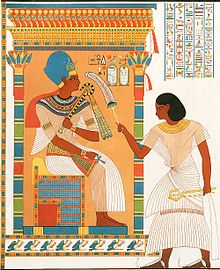| Amenhotep called Huy | |
|---|---|
 Huy before Tutankhamen in TT 40 | |
| Predecessor | Tuthmose (Viceroy of Kush) |
| Successor | Paser I |
| Dynasty | 18th Dynasty |
| Pharaoh | Tutankhamen |
| Mother | Wenher |
| Wife | Taemwadsji |
| Children | Paser I |
| Burial | TT40, Thebes |
Amenhotep called Huy was Viceroy of Kush under 18th Dynasty King Tutankhamen. He was the successor of Tuthmosis, who served under Akhenaten. He would later be succeeded by Paser I.[1]
Huy was the son of a lady named Werner by an unknown father. He had at least one brother, Mermose, who was the Second Prophet of Nebkheperure (Tutankhamun). Huy was married to Taemwadjsy, chief of the harem of Amun and of the Harem of Nebkheperure (Tutankhamun).[2] They had a son named Paser.[3]
Titles of Huy: King's son of Kush, Hereditary prince, King's Son overseer of the Southern Lands, Scribe of the letters of the viceroy, Merymose, King's scribe, Mery-netjer priest, King's messenger to every land.[4]
Huy held power spanning from Hierakonpolis to the Napatan area, conducting his governance from the protected city of Faras. He had numerous duties, including serving as a courier for Egyptian royalty. As "Overseer of all of the gold lands of Amun," Huy oversaw gold production operations, such as preserving mining sites, and collected Nubia's revenue, which included the collection of inw (gold, ivory, ebony, and other valuable goods). Depictions of this duty is depicted in the Southern Section of Huy's tomb.[5]
Other people associated with Huy:
- Harnufer, "Scribe of the gold-accounts of the king's son"
- Kna, "Scribe of the king's son" [6]
- ^ George A. Reisner: The Viceroys of Ethiopia (II), in: The Journal of Egyptian Archaeology, Vol. 6, No. 1. (Jan., 1920), pp. 73-88.
- ^ B. Porter and R.L.B. Moss: Topographical Bibliography of Ancient Egyptian Hieroglyphic Texts, Reliefs and Paintings: The Theban Necropolis, Part One: Private Tombs. Second Edition. Griffith Institute. Oxford. 1994, 75-78
- ^ B. Porter and R.L.B., Moss: Topographical Bibliography of Ancient Egyptian Hieroglyphic Texts, Reliefs and Paintings: The Theban Necropolis, Part One: Private Tombs. Second Edition. Griffith Institute. Oxford. 1994, 75-78
- ^ George A. Reisner :The Viceroys of Ethiopia (II), in: The Journal of Egyptian Archaeology, Vol. 6, No. 1. (Jan., 1920), pp. 73-88.
- ^ John Coleman Darnell and Colleen Manassa, Tutankhamun’s Armies (New Jersey: John Wiley & Sons, Inc., 2007), 106-109
- ^ George A. Reisner: The Viceroys of Ethiopia (II), In: The Journal of Egyptian Archaeology, Vol. 6, No. 1. (Jan., 1920), pp. 73-88.